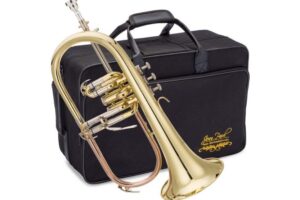Looking at a cello and a bass at a distance, they don’t look much different except for their size. While one instrument is larger than the other, they really look the same. What is the difference between a cello vs. bass?
11 of the key differences between a cello and bass are as follows:
- Size
- Tuning
- String Sizes
- Playing Position
- Sound
- Tuning Pegs and Scrolls
- Role in the Orchestra
- Tuning System
- Shoulders
- Back
- Bow
The cello’s tone is much deeper than the violin and the viola because of its thicker strings and larger body. It is the second-largest stringed instrument in an orchestra. The bass or double bass is the largest and is the lowest-pitched stringed instrument in any symphony orchestra.
Read on to learn more about the bass vs. cello, including how they are different and how they are similar.
Cello Vs Bass

What is the difference between a cello and a bass? One of the most noticeable differences between the cello and the bass is their size.
Although these two are the biggest stringed instruments in an orchestra, the bass is bigger than the cello. Size is what differentiates the two from each other.
The bass is the largest stringed instrument in an orchestra. Next to it is the cello. The bass is also the lowest-pitched of all stringed instruments. While the cello’s pitch is lower than the violin’s pitch, it is higher than the bass. This instrument is the one that produces the tenor voice in the orchestra.
There are many more differences between the cello and the bass. These differences will be discussed in detail in the remainder of this article:
1. Size
Even the casual observer will notice the size difference between the cello and bass. From a distance, both are similarly shaped like the violin. But at a closer look, the cello is definitely smaller than the bass. The bass is the largest stringed instrument in an orchestra.
It stands about 6 feet (182.88 cm.) from the floor, while the cello is noticeably smaller at around 5 feet (152.4 cm.). A full-size bass, which is about 6 feet and 5 inches, is taller than the average American man. The bass is so tall that a bassist needs to stand up to play it.
Of course, you can play it sitting down, but you need a high stool to do it. Meanwhile, a cello is always played sitting down. It is rather small to be played standing up unless you are really shorter than its height.
2. Tuning
Tuning is also different for each instrument. Cellos are typically tuned in 5ths from low to high (C, G, D, and A). On the other hand, Basses are usually tuned in 4ths (E, A, D, and G). The E of the bass is lower than the E of the cello.
Due to this practice of standard tuning, the cello has a wider tone range. They could reach up to about five octaves. Basses can only reach up to around four octaves.
3. String Size
The string sizes of cellos and basses are also very different in both length and thickness. That is why the range of notes for each of them can also be very different.
The bass’s thicker strings enable it to produce lower notes than the notes that the cello can produce. Bass notes can reach one full octave lower.
4. Playing Position
What is the difference between the playing positions when it comes to a cello vs. bass?
Cello
To play the cello, you have to sit down on an average chair. There is no other way unless you are shorter than the cello you are playing.
If you’re a beginner cellist, here’s a step-by-step guide on how to get to a playing position:
- Sit on a chair;
- Place the cello’s neck to the left of your head, with the C string tuning peg near to your left ear;
- Don’t slouch. Some cellists sit on their chair’s edge. Others like to sit fully on the chair for added support. Whatever position you prefer, you have to sit up straight;
- Adjust the cello’s endpin so that its body is resting against your chest and balance its lower half between your knees;
- Steady the cello with your knees; and
- Maintain the correct angle of the cello so that your bow can reach all the strings.
Bass
To play the bass, you need to stand up or use a high stool to play it sitting down:
- Stand straight with your feet at shoulder width;
- Adjust the cello’s endpin so that the nut at the fingerboard is at the same height as your eyebrows; and
- Position the bass slightly to your right and angle it back slightly. It should rest against your left hip.
Double Bass vs. Cello
Cello vs. double bass – what makes each of them unique? Double bass can be played while standing or sitting down in terms of playing position, while a cello can only be played while sitting down.
Bass Violin vs. Cello
Like other violins, a bass violin is played while holding near the shoulder or chin, while a cello, as mentioned earlier, is played while the player is seated.
5. Sound
In terms of sound, there’s a clear difference between a cello vs upright bass.
The cello is the string instrument that carries the tenor voice of the orchestra. Its tone is richer and deeper than that of the violin. The bass, on the other hand, can achieve an extra octave range.
Thus, it can produce a deeper sound than the cello. Therefore, their sound can also be considered as another element in this bass violin vs. cello differences.
Typically, a full symphony orchestra will have from 8 to 12 cellos and only a few basses. However, the bass can be found in nearly all kinds of Western music, making it one of the world’s most versatile string instruments.
The sounds of these two musical instruments, though different, complement each other. Basses have a thick, luxurious sound, which perfectly provides more weight to the cello’s pure and sweet sound. In the orchestra, a cello or bass provides a stable sound foundation.
6. Tuning Pegs and Scrolls
What is the difference between stand up bass vs. cello in terms of tuning pegs and scrolls?
The scrolls or headstocks of cellos are also different than those of basses. Cellos have small parts that are sticking out of the scroll’s side. These are called tuning pegs.
On the other hand, Basses have tuning knobs that are typically pointed towards the scroll’s back. Collectively, they are called tuning machines.
7. Role in the Orchestra
The difference between an upright bass vs. cello is also carried over in the roles that they play. These two instruments play different roles in the orchestra. Violins usually play the melody, harmony, and bass line support.
Cellos can also play these three roles depending on where they are placed in the orchestra.
In older orchestra music, the bass usually doubles the cello, but an octave lower. They are not expected, though, to follow the fast passages of the cello. When Beethoven came, the bass started to have a life of its own.
That started the expansion of the bass’ role in the orchestra. If need be, it can supply the low notes for the brass and woodwind sections.
The development of steel and tungsten strings has also transformed the role of basses in the orchestra. They now have the ability to speed up the notes even in low frequency, as can be allowed.
Bass players now have the ability to produce deafening and fast sounds from their instruments. Some orchestra pieces have sections where basses are on their own and seldom doubling the cellos.
Concerning their roles in the orchestra, some instrumentalists believe that there is no reason why you can get confused with the cello and the bass. The bass provides the lowest sound in stringed instruments. Its sound is pronounced, bigger, and enormous – much deeper than that of the cello.
Basses are also typically positioned way over on the stage’s right side. Their players are either standing up or seated on very high stools.
8. Tuning System
The tuning systems of cellos and basses are also different. Basses have the strings threads going through the tailpiece and are caught by the ball end. There is also a worm gear tuning machine to ensure that the larger metal drum will not slip.
There is a wooden friction peg at the head or scroll on a cello that winds the string on. A fine-tuning lever is attached to the tailpiece, where the end of the string is attached—the ball end hooks into the end of this lever.
9. Shoulders
The shoulders of these two instruments can also be rightly included in our cello vs. double bass differences. Looking closely at both the cello and the bass, you will notice some noticeable differences in their appearances.
It seems that the bass has more variations in its shoulder shape than the cello. For instance, the shoulders of the bass are more sloping than the cello.
Meanwhile, the shoulder of the cello shoulders is more rounded than the bass. Besides, the larger size of the bass makes it awkward for bassists to navigate around the instrument. Perhaps this is the reason why it was designed with sloped shoulders.
10. Back
The back of a cello is also different from the back of a bass. Cellos have backs that are flatter than the backs of basses. The backs of the basses are also flush with the outer rim of the instrument.
This is taken from the design of the violin, probably associated with the design of older contrabasses.
When you view a typical bass-stringed instrument from its side, you will not fail to notice that its back is curving outwards. This design element was taken from the viol de gamba, its predecessor.
11. Bows
What is the difference between the bows when it comes to a bass vs. cello?
Cello Bows
Cello bows are skinnier than bass bows. Their hairs are also much lighter than the hairs or strings of bass bows. These bows are typically 72 to 73 centimeters long. The stick is usually made of various materials.
The strongest cello bows are made of carbon fiber. But other materials such as fiberglass and Pernambuco are also regularly used. Pernambuco is regarded as the finest cello bow stick material because it is made from Brazilian high-grade wood.
Bass Bows
The bows for basses are 10 centimeters shorter than cello bows. They are also three times heavier and are also stronger. Bass bows are usually made of carbon fiber because they need to be strong and sturdy.
Bows for basses are available in two different designs. There is the German bow, and the other is the French bow. A Frenchman does not actually design the French bow.
It came from England. The German bow also did not come from Germany. An Italian designed it. Both bows are made of carbon fiber.
A bassist holds the French bow like he will hold a cello bow. The German bow, on the other hand, is held palm-up. The first two fingers and the thumb should hold the stick like holding a pencil.
The rest of the fingers control the bottom of the frog. This is the hand end of the hair, which is adjustable.
Unveil the truth about Jenna Ortega’s cello-playing skills right here.
Conclusion: Bass Vs Cello
The cello and the bass are different in the following aspects:
- Size
- Tuning
- String Sizes
- Playing Position
- Sound
- Tuning Pegs and Scrolls
- Role in the Orchestra
- Tuning System
- Appearance
- Back
- Bow
The shape of the cello and the bass is very similar. They look like big violins. But that is just their most obvious difference. There are a lot more differences, as you have seen described in detail in this article.
Due to their bigger size, both the cello and the bass can’t be played like violins, played standing up and locked in the violinist’s jaw.
The cello is always played sitting down, while the bass is usually played standing up. You can play the bass sitting down, but you have to use a high stool to do it.
Related reading:
Chaconne Vs Passacaglia – What Is the Difference Between Them?
Euphonium Vs Baritone – What Are the Differences?







![Read more about the article Different Types of Saxophones [4 Most Common and 6 Less Common]](https://musicalinstrumentpro.com/wp-content/uploads/2020/11/how-many-types-of-saxophones-are-there-300x200.jpg)

